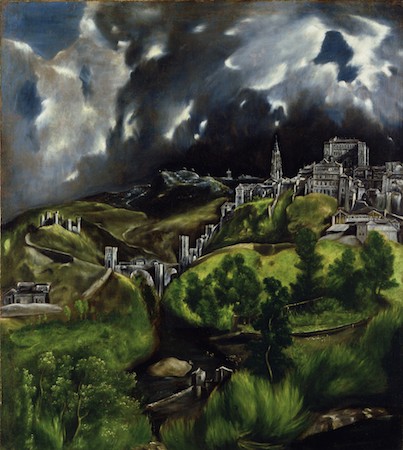El Greco, View of Toledo

Something new: A cityscape
To understand how radical this painting is, we have to weigh a few historical circumstances. First, El Greco was painting in Counter Reformation Spain, where religious dictates based on the Council of Trent (which ended in 1563), banned the landscape as a suitable subject for painting. Although the church was his primary patron, the artist broke with that convention, and because of this, View of Toledo has been called the first Spanish landscape. More impressively, cityscapes never existed anywhere in the sixteenth century. El Greco may literally have invented the genre. Some art historians found this so unsettling that they had suggested that, because El Greco often included views of Toledo in the backgrounds of his religious paintings and portraits, View of Toledo may have actually been cut from the background of a larger painting. However, we now know that this is not true.
The city of Toledo
Although El Greco, “the Greek,” is most usually known as a Spanish painter, he was born Domenikos Theotokopouolos in Crete in 1541, and spent much of his life in Italy. He was trained in the tradition of Byzantine icon paintings in either Crete or Venice, where many Cretans had settled, and by the 1560s was painting in Titian’s workshop. In the 1570s he went to Rome. Although El Greco was well reputed in Italy, he failed to secure any commissions in the city, and was convinced by a Spaniard to move to Toledo, where he spent the next forty years of his life, and where he died in 1614.
Why did the city of Toledo inspired El Greco to paint such a powerful picture of the city? In Spain, El Greco failed to find favor with the king, and instead worked for the Catholic Church. If he was not raised in the faith, he almost certainly would have had to convert to Catholicism. In the 1500s, Spain’s Catholic Church had undergone huge transformations. The century started with the Spanish Inquisition, in which non-Catholics were hunted out, tried, tortured, and often, killed. At the same time, people, like Saint Theresa of Avilla and Saint Ignatius of Loyola (both Spanish), were preaching that, through prayer, one could be directly inspired by God, and they claimed to have frequent visions in which God spoke to them. Because of their beliefs, even these saints came under the scrutiny of the Inquisition, although they were eventually acquitted. Spain’s brand of Catholicism, compared to Italy’s, was mystical and based on personal experience.
Mysticism and inner conflict
This mysticism is reflected in El Greco’s View of Toledo. Almost entirely subsumed by the landscape, the city seems to be at the direct mercy of God. This is not a forgiving God, but rather a wrathful one, as in the Old Testament. Toledo is undergoing a reckoning. At the same time, the landscape transcends this religious reading. It becomes reflective of the inner conflict of each human being, the feeling that making one’s way in the world is a harrowing endeavor.
- Christine Zappella, "El Greco, View of Toledo," in Smarthistory, August 9, 2015, accessed March 31, 2023, https://smarthistory.org/el-greco-view-of-toledo/. ↵

